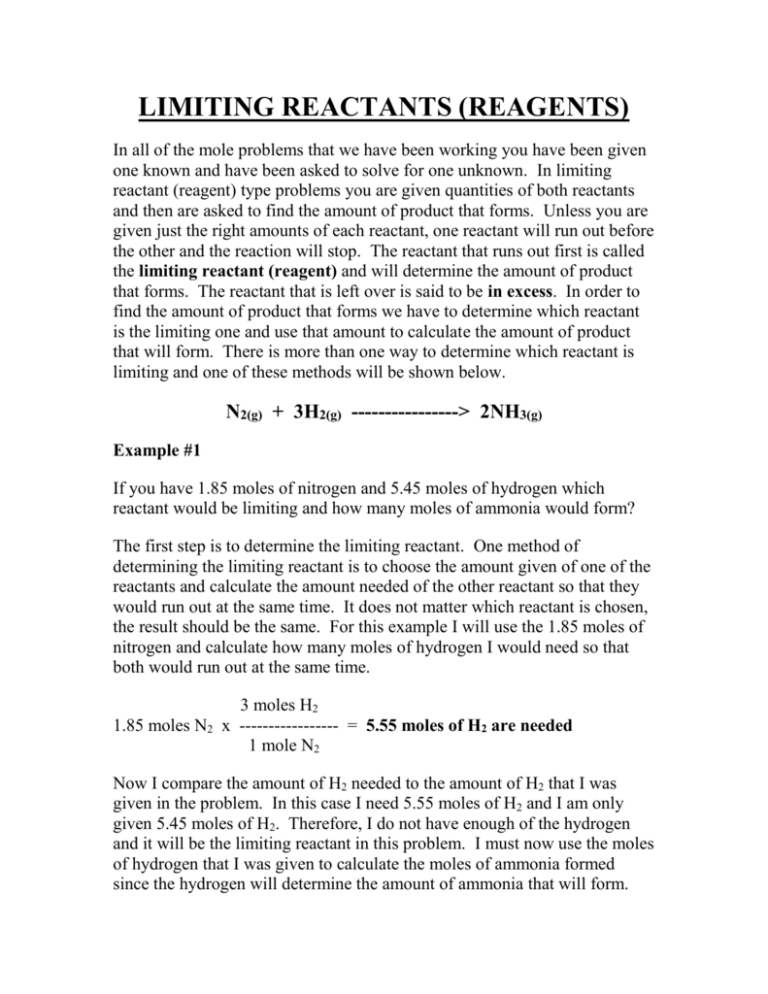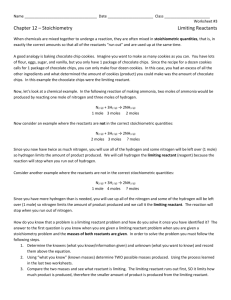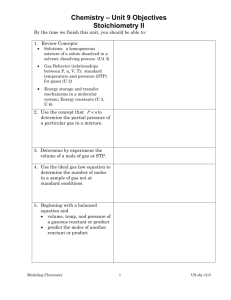LIMITING REACTANTS (REAGENTS) In all of the mole problems
advertisement

LIMITING REACTANTS (REAGENTS) In all of the mole problems that we have been working you have been given one known and have been asked to solve for one unknown. In limiting reactant (reagent) type problems you are given quantities of both reactants and then are asked to find the amount of product that forms. Unless you are given just the right amounts of each reactant, one reactant will run out before the other and the reaction will stop. The reactant that runs out first is called the limiting reactant (reagent) and will determine the amount of product that forms. The reactant that is left over is said to be in excess. In order to find the amount of product that forms we have to determine which reactant is the limiting one and use that amount to calculate the amount of product that will form. There is more than one way to determine which reactant is limiting and one of these methods will be shown below. N2(g) + 3H2(g) ----------------> 2NH3(g) Example #1 If you have 1.85 moles of nitrogen and 5.45 moles of hydrogen which reactant would be limiting and how many moles of ammonia would form? The first step is to determine the limiting reactant. One method of determining the limiting reactant is to choose the amount given of one of the reactants and calculate the amount needed of the other reactant so that they would run out at the same time. It does not matter which reactant is chosen, the result should be the same. For this example I will use the 1.85 moles of nitrogen and calculate how many moles of hydrogen I would need so that both would run out at the same time. 3 moles H2 1.85 moles N2 x ----------------- = 5.55 moles of H2 are needed 1 mole N2 Now I compare the amount of H2 needed to the amount of H2 that I was given in the problem. In this case I need 5.55 moles of H2 and I am only given 5.45 moles of H2. Therefore, I do not have enough of the hydrogen and it will be the limiting reactant in this problem. I must now use the moles of hydrogen that I was given to calculate the moles of ammonia formed since the hydrogen will determine the amount of ammonia that will form. 2 moles NH3 5.45 moles H2 x ------------------ = 3.63 moles NH3 3 moles H2 Example #2 If 14.5 grams of nitrogen react with 2.55 grams of hydrogen, how many grams of ammonia would form? What is the limiting reactant in this problem? Which reactant is in excess and by how much? The first step is to determine which reactant is limiting by finding how many grams of one reactant is needed to react with the other reactant so that they run out at the same time. 1 mole 3 moles H2 2.0 grams 14.5 grams N2 X -------------- X ---------------- X ------------------ = 3.1 grams of H2 are needed in the reaction 28.0 grams 1 mole N2 1 mole Now we compare the grams of H2 needed to the grams of H2 that we were given in the problem. We need 3.1 grams but we only have 2.55 grams, so the H2 will be the limiting reactant. We now need to use the amount of H2 given in the problem to find the number of grams of ammonia that will form. 1 mole 2 moles NH3 2.55 grams H2 X ---------------- X ---------------= 14 grams of NH3 2.0 grams 3 moles H2 X 17.0 grams -------------------1 mole The last step in the problem is to determine the amount of N2 that will be in excess. We need to calculate the amount of N2 that we would need to completely use up the 2.55 grams of H2 and then take the difference between what we need and what we have in order to determine the amount in excess. 1 mole 1 mole N2 28.0 grams 2.55 grams H2 X ----------------- X --------------------- X -------------------= 12 grams of N2 is needed 2.0 grams 3 moles H2 1 mole 14.5 grams N2 given - 12 grams N2 needed = 3 grams N2 in excess (the answer has been rounded because of significant figures)









